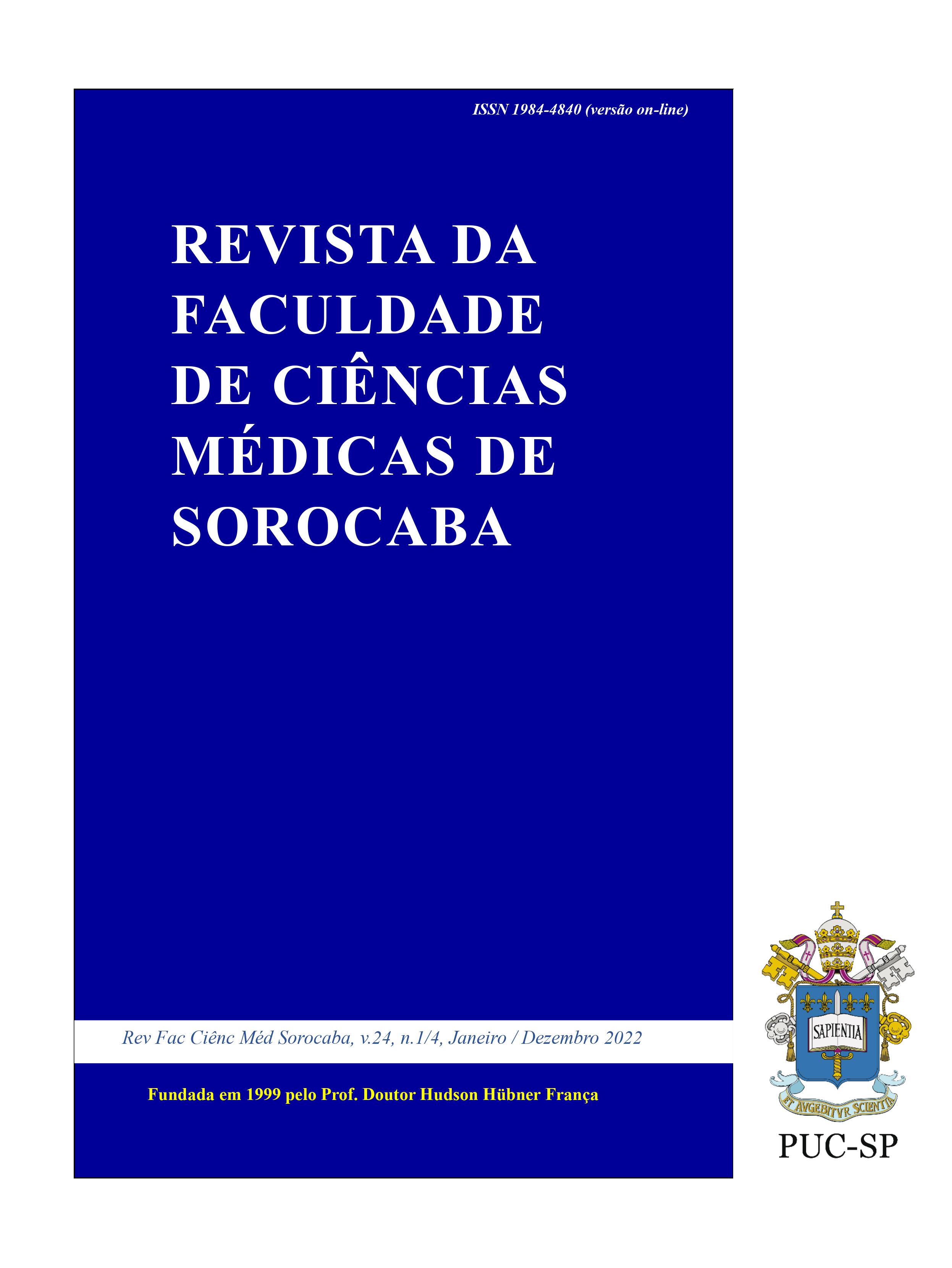Peripartum hysterectomy in a public hospital in the interior of the Brazilian northeast
DOI:
https://doi.org/10.23925/1984-4840.2022v24i1/4a9Keywords:
hysterectomy, peripartum period, uterine inertia, postpartum hemorrhageAbstract
Objectives: To trace the clinical, epidemiological and obstetric profile of women undergoing peripartum hysterectomy, as well as to identify the incidence and outcome of this procedure. Methods: Retrospective, longitudinal study with a quantitative approach carried out in the maternity ward of a public hospital in Picos-Piauí with all women who underwent peripartum hysterectomy from January 2020 to January 2022. Results: Seven patients underwent the procedure at the institution during the period study time period, which corresponded to a rate of 2.13 peripartum hysterectomies per 1000 births. The mean age was 33 years (±5.9 years), ranging from 27 to 39 years. Women from the macro-region of neighboring cities prevailed (85.8%), married (71.5%), brown (71.5%), farm workers (71.6%), and 57% studied up to elementary school. The mean length of hospital stay was 5.6 days (±2.7 years), ranging from 3 to 11 days. The diagnosis of bleeding syndromes prevailed, 85.8% required blood products, 42.8% required admission to the intensive care unit and 57.2% underwent subtotal hysterectomy. There was no evidence of death, 85% were discharged due to cure and only 15% were transferred. Conclusions: Most women were young, married, farmers, brown, pregnant and had a cesarean section. A large majority required blood transfusion and intensive care.
References
World Health Organizations. International Statistical Classification of Diseases and related health problems [Internet]. 10th ed. Geneva: WHO; 2010 [acesso em 19 maio 2022]. Disponível em: https://www.who.int/classifications/icd/ICD10Volume2_en_2010.pdf
Brasil. Ministério da Saúde. Secretaria de Atenção à Saúde. Departamento de Ações Programáticas Estratégicas. Manual dos comitês de mortalidade materna [Internet]. 3ª ed. Brasília (DF): Editora do Ministério da Saúde; 2007 [acesso em 15 maio 2022]. Disponível em: from:http://bvsms.saude.gov.br/bvs/publicacoes/manual_comites_mortalidade_materna.pdf
Van den Akker T, Brobbel C, Dekkers OM, Bloemenkamp KW. Prevalence, indications, risk indicators, and outcomes of emergency peripartum hysterectomy worldwide: a systematic review and meta-analysis. Obstet Gynecol. 2016;128(06):1281–94. doi: 10.1097/AOG.0000000000001736.
Bodelon C, Bernabe-Ortiz A, Schiff MA, Reed SD. Factors associated with peripartum hysterectomy. Obstet Gynecol. 2009;114(01):115–23. doi: 10.1097/AOG.0b013e3181a81cdd.
Calvo Aguilar O, Rosas Carvallar E, Vásquez Martínez J, Hernández Cuevas J. Histerectomía obstétrica en el Hospital General Dr. Aurelio Valdivieso, Oaxaca, México. Rev Chil Obstet Ginecol. 2016; 81(6):473-9. doi: 10.4067/S0717-75262016000600004
Ramilo I, Caeiro AF, Mendinhos G, Santos AP, Matos F. Histerectomia pós-parto: revisão de 15 anos. Acta Obstet Ginecol Port. 2015;9(1):16-22.
Cromi A, Candeloro I, Marconi N, Casarin J, Serati M, Agosti M, Ghezzi F. Risk of peripartum hysterectomy in births after assisted reproductive technology. Fertil Steril. 2016;106(3):623-8. doi: 10.1016/j.fertnstert.2016.05.005.
Mendonça AS, Dias JMG. Prevalência de histerectomia pós-parto em maternidade pública do Estado de Sergipe. Rev Med Minas Gerais. 2018;25(2):168-74.
Wani RV, Abu-Hudra NMS, Al-Tahir SI. Emergency peripartum hysterectomy: a 13-year review at a tertiary center in Kuwait. J Obstet Gynaecol India. 2014;64(6):403-8. doi: 10.1007/s13224-014-0554-z.
Kazi S. Emergency peripartum hysterectomy: a great obstetric challenge. Pak J Med Sci. 2018;34(6):1567–70. doi: 10.12669/pjms.346.13686.
Tang Ploog Luis E., Albinagorta Olórtegui Roberto. Histerectomía puerperal: experiencia en una institución privada. Rev Peru Ginecol Obstet. 2013;59(3):195-8.
Yildirim GY, Koroglu N, Akca A, Talmac M, Dikmen S, Gokhan Yıldırım G, et al. What is new in peripartum hysterectomy? A seventeen year experience in a tertiary hospital. Taiwan J Obstet Gynecol. 2021;60(1):95-8. doi: 10.1016/j.tjog.2020.11.014.
Ingelmo JMR, Motellón A, Millá A, Gutiérrez LS, Correa JBG, Oltra MF, et al. Histerectomía periparto en el Hospital General Universitario de Elche. Clin Invest Gin Obst. 2014;41(3):98-103.
Dorigon A, Martins-Costa SH, Ramos JGL. Peripartum hysterectomies over a fifteen-year period. Rev Bras Ginecol Obstet. 2021;43(1):1-8. doi: 10.1055/s-0040-1721354.
Souza LS, Souza AF. Histerectomia pós-parto de emergência em maternidade pública de cuidados de alto risco no estado do Amazonas. Rev Eletrôn Acervo Saúde. 2019; 32(1):1-12. doi: 10.25248/reas.e1618.2019.
Sakse A, Weber T, Nickelsen C, Secher NJ. Peripartum hysterectomy in Denmark 1995-2004. Acta Obstet Gynecol Scand. 2007;86(12):1472-5. doi: 10.1080/00016340701692651
Estrada ROV, Falero AS, Reyes MAS, Rizo MM. Histerectomía obstétrica de urgencia. Rev Cubana Obstet Ginecol. 2009;35(3):1-10.
Kwee A, Bots ML, Visser GHA, Bruinse HW. Emergency peripartum hysterectomy: a prospective study in The Netherlands. Eur J Obstet Gynecol Reprod Biol. 2006;124(2):187-92. doi: 10.1016/j.ejogrb.2005.06.012.
Briery CM, Rose CH, Hudson WT, Lutgendorf MA, Magann EF, Chauhan SP, et al. Planned vs emergent cesarean hysterectomy. Am J Obstet Gynecol. 2007;197(2):154.e1-5. doi: 10.1016/j.ajog.2007.03.026.
Downloads
Published
How to Cite
License
Copyright (c) 2023 Revista da Faculdade de Ciências Médicas de Sorocaba

This work is licensed under a Creative Commons Attribution-NonCommercial 4.0 International License.
Os autores no momento da submissão transferem os direitos autorais, assim, os manuscritos publicados passam a ser propriedade da revista.
O conteúdo do periódico está licenciado sob uma Licença Creative Commons 4.0, esta licença permite o livre acesso imediato ao trabalho e que qualquer usuário leia, baixe, copie, distribua, imprima, pesquise ou vincule aos textos completos dos artigos, rastreando-os para indexação, passá-los como dados para o software, ou usá-los para qualquer outra finalidade legal.

 Este obra está licenciada com uma Licença
Este obra está licenciada com uma Licença 